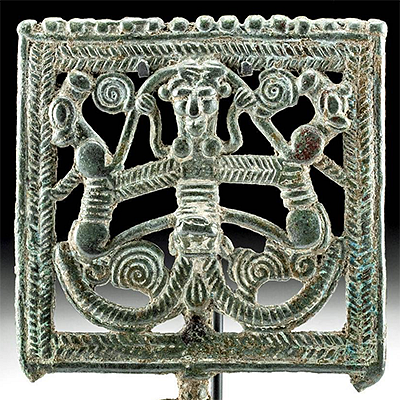Huge 20th C. African Songye Wood Nkisi Kalebwe Statue
Lot 91c
About Seller
Artemis Fine Arts
686 S Taylor Ave, Ste 106
Louisville, CO 80027
United States
Selling antiquities, ancient and ethnographic art online since 1993, Artemis Gallery specializes in Classical Antiquities (Egyptian, Greek, Roman, Near Eastern), Asian, Pre-Columbian, African / Tribal / Oceanographic art. Our extensive inventory includes pottery, stone, metal, wood, glass and textil...Read more
Categories
Estimate:
$2,000 - $3,000
Absentee vs Live bid
Two ways to bid:
- Leave a max absentee bid and the platform will bid on your behalf up to your maximum bid during the live auction.
- Bid live during the auction and your bids will be submitted real-time to the auctioneer.
Bid Increments
| Price | Bid Increment |
|---|---|
| $0 | $25 |
| $300 | $50 |
| $1,000 | $100 |
| $2,000 | $250 |
| $5,000 | $500 |
| $10,000 | $1,000 |
| $20,000 | $2,500 |
| $50,000 | $5,000 |
| $100,000 | $10,000 |
| $200,000 | $20,000 |
About Auction
By Artemis Fine Arts
Nov 5, 2020
Set Reminder
2020-11-05 10:00:00
2020-11-05 10:00:00
America/New_York
Bidsquare
Bidsquare : Ancient & Ethnographic From Around the World
https://www.bidsquare.com/auctions/artemis-gallery/ancient-ethnographic-from-around-the-world-5916
Ancient art from Egypt, Greece, Italy and the Near East, as well as Asian, Pre-Columbian, Native American, African / Tribal / Oceanic, Spanish Colonial, Russian Icons, Fine art, much more! All categories, all price ranges... all legally acquired and guaranteed to be as described or your money back. Artemis Fine Arts info@artemisfinearts.com
Ancient art from Egypt, Greece, Italy and the Near East, as well as Asian, Pre-Columbian, Native American, African / Tribal / Oceanic, Spanish Colonial, Russian Icons, Fine art, much more! All categories, all price ranges... all legally acquired and guaranteed to be as described or your money back. Artemis Fine Arts info@artemisfinearts.com
- Lot Description
Central Africa, northern Democratic Republic of the Congo, Songye peoples, ca. early 20th century CE. A hand-carved wooden figure known as a nkisi (male) power figure of a substantial size standing with delineated legs and angular thighs atop an integral conical plinth. The stylized figure features a distended abdomen with a recessed cavity in the navel, a horizontal ridge across the chest, broad shoulders, and wide arms bent at the elbow. The ringed cylindrical neck traces up to the bulbous head which showcases crescent-shaped eyes, a triangular nose above protruding, smiling lips, a squared-off chin, and a broad forehead lined with hammered copper panels. A cavity atop the head originally held a horn symbolic of a power conduit. Rich brown patina covers the entire figure and provide for an attractive presentation. Size: 10" W x 45.25" H (25.4 cm x 114.9 cm)
Songye power figures are created to protect a community and mediate between the living and spiritual realms to cure ailments. Figures that are employed in ceremonial uses have real horns protruding from the center of the head and often also exhibit hammered brass panels which are applied to the face. Power figures are kept in a sanctuary under the care of a guardian when not in use.
The piece exhibits a few characteristics which are unique to Songye artistry. Kalebwe figures, from the northern region of the Democratic Republic of the Congo, tend to have chins with a square profile rather than rounded chins typical of the southern Kibeshi figures. The second feature is the hollowed receptacle at the top of the head which is intended for the insertion of fetish material, known as "bishimba," which symbolically imbues the figure with special powers. According to Jean-Baptist Bacquart, "A 'specialist', called the Nganga, then attached magical objects such as snakeskins, feathers, metal necklaces and bracelets to the figure to enhance the power even more. Occasionally these figures are suspended for apotropaic purposes inside a house by inserting a metal rod under each arm." ("The Tribal Arts of Africa: Surveying Africa's Artistic Geography." Thames & Hudson, New York, 2000, p. 168)
Provenance: private Orange, California, USA collection, acquired in the 1930s
All items legal to buy/sell under U.S. Statute covering cultural patrimony Code 2600, CHAPTER 14, and are guaranteed to be as described or your money back.
A Certificate of Authenticity will accompany all winning bids.
We ship worldwide and handle all shipping in-house for your convenience.
#159671Repair to back of base, with possible restoration to phallus, with small chips and light adhesive residue along new material and break lines. Original horn atop head missing as shown. Abrasions and light inactive insect damage to base, body, limbs, and head, and minor indentations and encrustations to copper panels. Nice patina to wood and copper panels.Condition
- Shipping Info
-
All shipping is handled in-house for your convenience. Your invoice from Artemis Gallery will include shipping calculation instructions. If in doubt, please inquire BEFORE bidding for estimated shipping costs for individual items.
-
- Buyer's Premium



 EUR
EUR CAD
CAD AUD
AUD GBP
GBP MXN
MXN HKD
HKD CNY
CNY MYR
MYR SEK
SEK SGD
SGD CHF
CHF THB
THB















